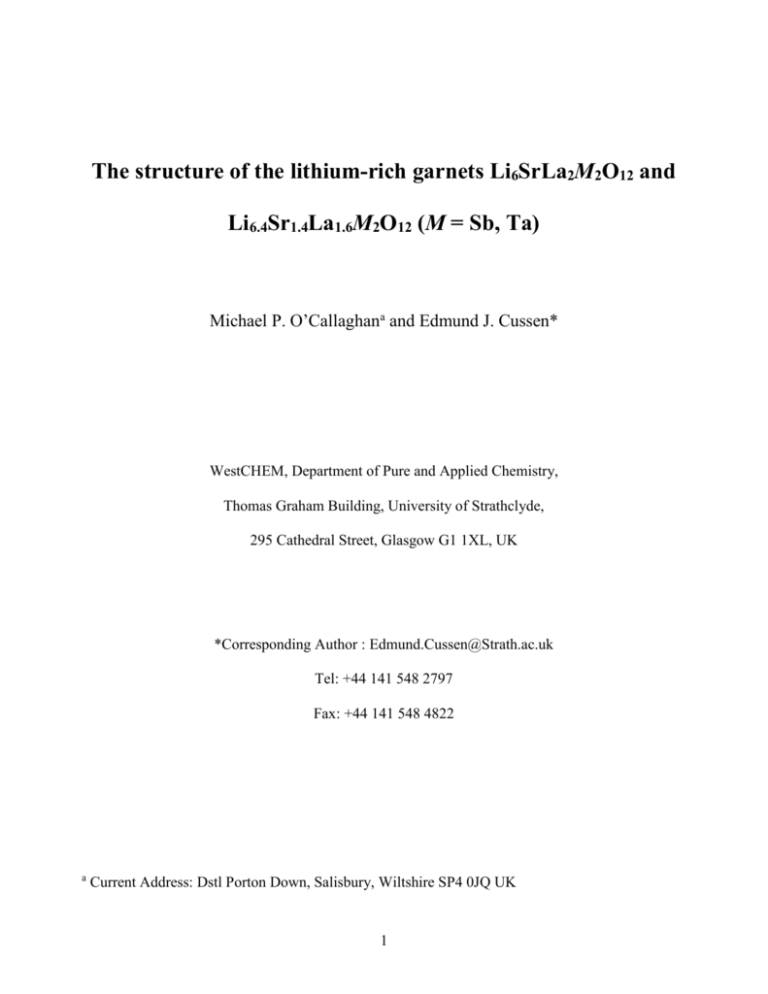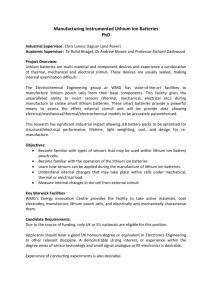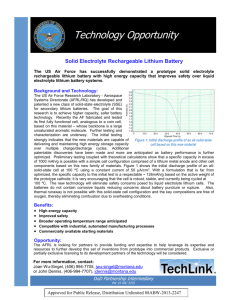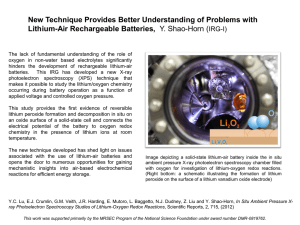Revised EJCussen Li rich Garnets text
advertisement

The structure of the lithium-rich garnets Li6SrLa2M2O12 and Li6.4Sr1.4La1.6M2O12 (M = Sb, Ta) Michael P. O’Callaghana and Edmund J. Cussen* WestCHEM, Department of Pure and Applied Chemistry, Thomas Graham Building, University of Strathclyde, 295 Cathedral Street, Glasgow G1 1XL, UK *Corresponding Author : Edmund.Cussen@Strath.ac.uk Tel: +44 141 548 2797 Fax: +44 141 548 4822 a Current Address: Dstl Porton Down, Salisbury, Wiltshire SP4 0JQ UK 1 Abstract Lithium garnets of the composition Li6SrLa2M2O12 and Li6.4Sr1.4La1.6M2O12 (M = Sb, Ta) have been prepared by solid state methods. Structural refinement against neutron powder diffraction data shows that these compounds crystallise in the space group Ia 3 d with lattice parameters in the range a = 12.85750(14) Å for Li6SrLa2Ta2O12 to 12.91371(13) Å for Li6.4Sr1.4La1.6Sb2O12. The observed increase in lattice parameter between M = Ta and Sb in both the Li6SrLa2M2O12 and Li6.4Sr1.4La1.6M2O12 compounds arises as a result of the different polarisabilities of these two cations. These phases contain a disordered arrangement of Sr2+/La3+ in eightfold coordination and Ta/Sb in fully-occupied oxide octahedra. All compounds contain lithium in a mixture of partially occupied tetrahedral and octahedral interstices with considerable positional disorder observed in the latter. Increasing the lithium stoichiometry causes a reduction in the occupation of the tetrahedrally-coordinated sites and a simultaneous increase in the concentration of lithium found within the oxide octahedra. 2 Introduction The desire for increased power density in rechargeable batteries, dictated by the increasing miniaturisation and functionality of modern electronic devices, has led to the emergence of lithiumion batteries as the leading technology to meet this energy demand [1]. The development of an allsolid-state lithium battery has several advantages over current technology which employs a polymer-based electrolyte, such as reduced toxicity and environmental impact, coupled with effective operation at high temperatures. However, most crystalline fast lithium conductors are unsuitable for operation in a rechargeable battery [2]. Lithium garnets have recently been identified as potential materials for application as solid state electrolytes as a result of their high room temperature conductivity (~1 10-5 S cm-1), negligible electronic conductivity and stability when in contact with air, moisture and lithium [3, 4]. In order to understand and optimise these materials a detailed structural model is required. We have recently carried out neutron diffraction studies of the fast-ion conducting series Li5+xLa3-xBaxTa2O12 (0< x ≤1.6) and have shown that all these compounds adopt the space group Ia 3 d , with lithium occupying both tetrahedral and distorted octahedral sites that are linked via shared polyhedral faces [5]. The proximity of these two interstitial sites (~2.1 Å) has been shown to result in the displacement of the octahedral lithium away from a shared face to increase the distance between these two centres to at least 2.4 Å. For Li6.6Ba1.6La1.4Ta2O12 the majority occupation of these two sites results in most Li+ having a local neighbouring Li+ at a distance of 2.47(1) Å. Of the title compounds, only Li6SrLa2Ta2O12 has previously been reported [4]. This compound was structurally characterised by X-ray diffraction in the space group I213 and impedance spectroscopy shows fast Li+ conductivity (σRT = 7 × 10-6 S cm-1, Ea = 0.50 eV) albeit an order of magnitude less than the barium analogue. The present study aims to compare the structures of strontium- and 3 barium-doped compounds. Moreover, studies of Li5La3Ta2O12 [6] and Li5La3Sb2O12 [7] found an unexpected variation in the lattice parameters between these two phases that arises from a variation in polarisability between d0 and d10 cations. The compounds in the present study can be considered to arise from the strontium doping of these two phases and so will also allow us to follow this difference between d0 and d10 cations as the lattice parameter and lithium content are adjusted by the introduction of the Sr2+ cation. Experimental All compounds were prepared using standard high temperature routes from stoichiometric mixtures of the starting materials 7LiOH.H2O, Sr(NO3)2, La2O3 and Sb2O3 or Ta2O5. In all cases a 10 % excess of 7LiOH.H2O was added to the initial reaction mixture to compensate for the evaporation of lithium during the reaction. The reagents were intimately ground and pressed into pellets of 13 mm diameter and heated from room temperature to 700 oC at 1 oC min-1 and held at this temperature for 12 hours. The reaction mixture was then ground, repelleted and heated at 900 oC for 12 hours. This second stage was repeated up to five times until a sample of sufficient purity was obtained. At the end of the final heating the samples were removed from the furnace and allowed to cool to room temperature over the course of a few minutes. The reactions were followed using a Philips Xpert powder diffractometer operating in Bragg Brentano geometry with Cu Kα radiation and the reactions were judged to be complete when the data could be fully indexed using a body-centred cubic cell typical of the garnet structure. Structure determinations were carried out by analysis of neutron diffraction data collected over the d-spacing 4 range 0.4≤ d / Å ≤8 by three banks of detectors of the time-of-flight instrument Polaris at Rutherford Appleton Laboratory, Didcot, UK. Data were collected from 2-5 g of sample contained in a cylindrical vanadium sample holder and were fitted using the GSAS implementation [8] of the Rietveld method [9] of structural refinement. A convolution of pseudo-Voigt and double exponential functions was used to describe the peak shape and the background was modelled using a shifted Chebyshev polynomial. Bond valence sums were calculated using literature values for bond-valence parameters [10]. Results Of the four compounds under discussion only Li6SrLa2Ta2O12 has been previously reported and so the structural analysis of these compounds started with this composition. Li6SrLa2Ta2O12 has been the subject of a characterisation by X-ray powder diffraction that identified the space group I213, a = 12.808(2) Å [4]. However, we have previously shown that a similar assignment to Li6BaLa2Ta2O12 underestimated the symmetry of this phase [5]. Careful examination of the diffraction data collected from Li6SrLa2Ta2O12 showed that the majority of peaks could be indexed using a body-centred cubic cell with a lattice parameter, a = 12.8575(2) Å. There were a number of additional peaks that could not be indexed using this cell and were identified as arising from a lithium carbonate impurity (≤ 0.7(1) wt%) or from the vanadium sample holder used in the neutron scattering experiments. Neither the X-ray diffraction data nor the neutron diffraction data contained any peaks arising from the garnet that could not be indexed using the systematic absences uniquely associated with Ia 3 d , indicating that Li6SrLa2Ta2O12 shares the symmetry of the series Li5+xBaxLa3-xTa2O12 [5, 6]. Therefore the structural refinement of Li6SrLa2Ta2O12 proceeded by using Li6BaLa2Ta2O12 as a starting model. 5 This structure features a single 8-coordinate crystallographic site that contains Sr2+ and La3+ in a random distribution compatible with the composition of the compound, i.e. a 1:2 ratio in the case of Li6SrLa2Ta2O12. The high symmetry octahedral site conventionally occupied in the garnet structure is fully occupied by Ta5+ and oxide anions occupy general positions in the cell. The lithium distribution is more complex as the tetrahedral site of the garnet structure is capable of accommodating only three cations per formula unit. In Li6BaLa2Ta2O12 the lithium is found to partially occupy this site and an additional highly-distorted oxide octahedron and so the refinement of Li6SrLa2Ta2O12 proceeded by placing a stoichiometric quantity of lithium across these two sites. This resulted in exceptionally large displacement parameters for the lithium on the octahedrallycoordinated site indicative of the positional disorder that has been observed in other lithiumconducting garnets [5, 6]. In common with previous reports this was modelled using a complex distribution of lithium within the distorted octahedron; lithium is refined near the centre of the octahedron on a 48g site and an additional 96h site is occupied by lithium cations that are displaced from the centre of the octahedron to yield two extra lithium sites per octahedron. Due to the minority lithium occupancy of both the 48g and 96h sites a single, isotropic displacement parameter was used to describe the disorder of all lithium cations in the structure. The displacements of all other species were modelled using an anisotropic description. This model readily refined to convergence and trial refinements using alternative lithium displacements and distributions consistently refined to yield a unique arrangement of lithium across these three crystallographic sites. This structural model was applied to the neutron diffraction data collected from the other three compounds and in every case provided a satisfactory match to the observed diffraction profile. The resultant fit and structural parameters are collected in Table 1 and the displacement parameters are 6 shown in Table 2. The variation in lattice parameters and lithium site occupancies are illustrated in Figures 4 and 5 respectively and selected interatomic distances for all four compounds are compared in Table 3. 7 Discussion The structures of Li6SrLa2M2O12 and Li6.4Sr1.4La1.6M2O12 (M = Sb, Ta) show many features that have been observed previously in lithium-containing garnets and provide a valuable comparison to the structures of Li5+xBaxLa3-xTa2O12. In all four compounds the metal-oxide bond lengths for nonlithium species are in good agreement with those expected for these cations. The lithium partially occupies both oxide tetrahedra and octahedra. The lithium in the latter is distributed over two crystallographic sites and, as the tetrahedra and octahedra are linked by a shared face, this positional disorder leads to a range of lithium-lithium separations. Due to the vacancy concentration on these sites it is probable that the shortest interatomic separations (Li...Li ≈ 1.5 Å and ≈ 1.98 Å) are avoided by local ordering as observed in other highly disordered ion conductors [11]. However, it has been shown [12] that Li...Li distances as short as 2.44 Å can exist in the garnet structure and so in the current compounds it is probable that the longer interatomic separation (≈ 2.4 Å) provides an accurate indication of local Li...Li distances. The lithium environments are similar to those reported previously [5, 6, 12] with the environment of the tetrahedrally-coordinated site being slightly overbonded (Li(24d) bond valence sum = 1.14) whilst the site at the centre of the distorted oxide octahedron provides a highly-irregular, underbonded coordination environment for lithium (Li(48g) bond valence sum = 0.88). The observed displacement of lithium from the centre of the octahedron increases the bonding interaction (Li(96h) bond valence sum = 0.94). We note that, as in other lithium-rich garnets [13], some of these lithium-oxide distances are longer than would be anticipated for a bonding interaction and as a consequence of this the lithium on the 48g and 96h sites have coordination numbers which are reduced from the six implied by the presence of an octahedron of oxide anions. The increase in population of the oxide octahedra with the simultaneous increase in vacancy concentration on the 8 tetrahedral site is a feature of the garnet structure that has previously been observed in the Li5+xBaxLa3-xTa2O12 series [5]. Comparison of garnets containing d0 (W6+, Ta5+, Nb5+) and d10 (Te6+, Sb5+) cations on the octahedrally coordinated site have identified an increased lattice parameter associated with the presence of d10 cations [7]. The lattice parameters of the two series Li5+xSrxLa3-xSb2O12 and Li5+xSrxLa3-xTa2O12 reproduce this observation. Despite the slightly larger size [14] of Ta5+ (rTa5+ = 0.64 Å) compared to Sb5+ (rSb5+ = 0.60 Å) the garnets containing Sb5+ are systematically expanded compared to the Ta5+ analogues as shown in Figure 4. Whilst the Sb/Ta-O bond lengths are almost constant across all four compounds, examination of the Sr/La-O bonds shows that these interatomic distances are consistently larger in the Sb5+ system than in the Ta5+ analogues; by 0.74 % for Li6SrLa2M2O12 and 0.67 % for Li6.4Sr1.4La1.6M2O12. This extension of the Sr/La-O bonds leads to an increase in the lattice parameters on replacing Ta5+ with Sb5+ of 0.35 % and 0.33 % for Li6SrLa2M2O12 and Li6.4Sr1.4La1.6M2O12 respectively. The Sr/La-O square antiprisms are linked via shared edges to form two interpenetrating body-centred networks and so propagate this bond extension throughout the lattice. The increase in bond lengths can be partially offset by a slight buckling of the Sr/La-O network, with no reduction in symmetry, and it can be seen that the Sr/LaO-Sr/La angle is reduced as the Sr/La-O distance increases. The change in lattice parameters is thus smaller than might be anticipated from the change in bond lengths. Similar effects have been observed in response to varying the size of cation on the 8-coordinate site in the series Li3Ln3Te2O12 [12]. All other aspects of the structure remain relatively constant. Indeed the similarity of Sb-O and Ta-O bond lengths in these compounds is greater than could be anticipated from the ionic radii, and so the variation in Sr/La-O distances cannot arise as a response to mechanical strain introduced elsewhere in the structure by this change of pentavalent cation. Instead this apparent change in 9 bonding behaviour of the 8-coordinate cations can be rationalised by comparing the polarisabilities of these cations. The increased polarisability of Sb5+ compared to Ta5+ results in an increased electron density on the oxide anion in the Li5+xSrxLa3-xSb2O12 system. As a consequence of this, the valence requirements of Sr2+/La3+ can be satisfied by a longer metal-oxide distance and propagation of this lengthening leads to expansion of the unit cell. Acknowledgements The authors are grateful to the Royal Society for the provision of a University Research Fellowship, to EPSRC and the University of Strathclyde for funding and to Dr R. Smith at ISIS for assistance with the neutron diffraction experiments. 10 Figure Captions Figure 1 The structure of Li6BaLa2Ta2O12 [5] can be viewed (a) as a body centred array composed of edge linked Ba/LaO8 units shown in grey with interstitial sites occupied by Ta5+ and Li+ represented by light grey and black spheres respectively. The lithium cations are found in (b) partially occupied tetrahedral and octahedral interstices. There is considerable positional disorder in the latter illustrated by the three lithium positions within the single oxide octahedron. Figure 2 Observed (dots), calculated (line) and difference neutron diffraction patterns collected from (a) Li6SrLa2Sb2O12 and (b) Li6.4Sr1.4La1.6Sb2O12 at room temperature. The insets show the quality of fit at lower d-spacings. The allowed reflections are indicated by markers. For Li6SrLa2Sb2O12 the reflections arising from the garnet, lithium carbonate and vanadium sample holder are indicated by the bottom, middle and top markers respectively. Figure 3 Observed (dots), calculated (line) and difference neutron diffraction patterns collected from (a) Li6SrLa2Ta2O12 and (b) Li6.4Sr1.4La1.6Ta2O12 at room temperature. The insets show the quality of fit at lower d-spacings. The allowed reflections arising from the garnet, lithium carbonate and vanadium sample holder are indicated by the bottom, middle and top markers respectively. Figure 4 The lattice parameters of Li5+xSrxLa3-xSb2O12 (squares) and Li5+xSrxLa3-xTa2O12 (triangles). The line is included as a guide to the eye and has no numerical significance. Values for the lattice parameters of Li5La3Ta2O12 and Li5La3Sb2O12 are taken from the literature [6, 7] 11 Figure 5 The occupancy of the tetrahedral (triangles) and octahedral (squares) interstitial sites in Li5+xSrxLa3-xTa2O12 (top) and Li5+xSrxLa3-xSb2O12. The line is included as a guide to the eye and has no numerical significance. Values for the site occupancies of Li5La3Ta2O12 and Li5La3Sb2O12 are taken from the literature [6, 7]. 12 References 1. J.-M. Tarascon, M. Armand, Nature, 414 (2001), 359. 2. V. Thangadurai, W. Weppner, Ionics, 12 (2006), 81. 3. V. Thangadurai, H. Kaack, W. J. F. Weppner, J. Am. Ceram. Soc., 86 (2003), 437. 4. V. Thangadurai, W. Weppner, Adv. Funct. Mater., 15 (2005), 107. 5. M. P. O’Callaghan, E. J. Cussen, Chem. Commun., 20 (2007). 6. E. J. Cussen, Chem. Commun., (2006), 412. 7. E. J. Cussen, T. W. S. Yip, J. Solid State Chem., 180 (2007), 1832. 8. A. C. Larson, R. B. von Dreele, General Structure Analysis System (GSAS); Los Alamos National Laboratories: 1990. 9. H. M. Rietveld, Acta Cryst., 2 (1969), 65. 10. N. E. Brese, M. O'Keeffe, Acta Cryst., B47 (1991), 192. 11. I. Abrahams, P. G. Bruce, W. I. F. David, A. R. West, Acta Cryst., B45 (1989), 457. 12. M. P. O'Callaghan, D. R. Lynham, G. Z. Chen, E. J. Cussen, Chem. Mater., 18 (2006), 4681. 13. J. Percival, P. R. Slater, Solid State Commun., 142 (2007), 355. 14. R. D. Shannon, Acta Cryst., A 32 (1976), 751. 13







